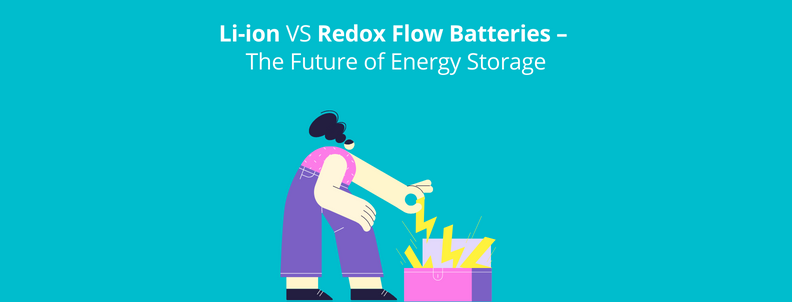Renewables are expected to supply four-fifths of the world’s electricity by 2050, massively cutting down carbon emissions and helping to mitigate climate change. But what do you do when no sun or no wind is blowing to generate energy? One solution is to store the energy during sunny afternoons and windy days.
The only way to meet our global energy demands through renewable sources is to store the energy produced to sustain the power supply. Thus, the growing use of renewable energy sources is pumping the growth of another closely associated sector – energy storage. It is expected that by 2028, the energy storage market will cross $ 13.2 billion. (Source)
There are various energy storage systems, such as well-known lithium-ion and lead-acid batteries. But, despite being well known and well established in the market, Li-ion batteries have some challenges.
Lithium-ion batteries exhibit high energy density, but for power grid requirements, these batteries must be assembled in parallel to grow the current capability or in series to increase the voltage. However, to achieve a high voltage, when many cells are connected in series, it results in unevenly divided voltage among these cells. This results in some cells having fully charged and other cells being overcharged. LIBs do not deal well with overcharging, resulting in potential safety issues and limited cycle life of the system. Also, LIBs are extremely sensitive to high temperatures and are inherently flammable. Thus, overall LIBs pose serious challenges because of stability and safety issues. (Source).
If you wonder, is there a solution to these challenges, well, there is!
Redox flow battery – Safer Alternatives to Lithium Ion Batteries
In recent years, another type of battery known as redox flow battery has entered the segment. The RFB market is expected to take 35% of the energy storage market by reaching a 4.5 billion market value by 2028. (Source)
Redox flow batteries are different from lithium-ion batteries as the active materials (electrolytes) in RFBs are stored separately in huge tanks and pumped into the cell according to the energy demand. These electrolytes are recycled during the charge-discharge of the battery. These RFBs offer several advantages, such as >25 years of operating life, and most importantly, these batteries are non-flammable, non-toxic, and therefore pose no risk of explosion.
It is not just about the companies entering the domain; even governments across the globe are funding and setting up RFB projects. China is underway with the construction of the largest battery in the world (200 MW/800 MWh), which will be entirely powered by redox flow batteries. (Source)
Looking at the market and the response of the government and major players, it is common to assume RFBs will take over lithium-ion batteries. But, how true is it?
Can RFBs take over the lithium-ion battery?
Undoubtedly, RFBs solve the major issue of flammability with Li-ion batteries, but lithium-ion still offers better performance than RFBs. Lithium-ion batteries offer the highest energy density in the rechargeable-battery market (100-265 Wh/kg). This makes charging a lithium-ion battery easier, faster, and long-lasting. (Source)
They also have high voltage capacity and lower self-discharge rates. (Source) Whereas RFBs, at the moment, face performance issues (high self-discharge, chemical and mechanical stability of battery components, etc.) but also have maintenance issues. For example, Flow batteries have complex plant Setup needs, including pumps, plumbing, and electrolyte tanks for electrolyte management. All of this adds capital costs and operation and maintenance requirements. (Source)
And, hence Lithium-ion batteries outperform RFBs and pose a major roadblock to their growth. (Source)
However, the RFB domain has seen intense research and innovations since 2011. Innovation (i.e., patent filings) in 2018 was twice that of 2011. Similarly, research articles in the RFB domain have grown exponentially. It will be worth watching the growth of energy storage systems, how companies are innovating and which type of battery takes the lead.
Note: A dip in innovation and research counts in 2021 and 2022 is primarily due to a delay in the publication of the data and should not be construed as a dip in research and/or innovation.
What does Research and inventions growth in the RFB sector denotes?
The increased innovation in RFBs in 2018 could be due to the increased adoption of renewable energy and its suitability for energy storage at a large scale due to some of its inherent advantages such as long life, safer, and being eco-friendly as compared to lithium-ion batteries. Big players such as Sumitomo Electric Industries, Kansai Electric Power, Dalian Rongke Power, and LG Chemicals are some of the top players innovating in this domain. The inventions mainly focus on the battery components such as electrodes, electrolytes, and separators to improve battery performance and bring down the overall cost.


How can GreyB help you make business-centric decisions while venturing into a new domain?
Usually, when a domain seems lucrative, we want to jump on the bandwagon immediately. However, these decisions need careful assessment of not just the domain but your interests, expertise, and limitations. GreyB can help you to make this assessment. Not just this, if we find that the domain benefits you, we will also help you strategize how to innovate and position yourself in the industry.
Interested in other energy storage trends of 2023? Download our exclusive report by filling out the form below:
Author: Megha Aggarwal, Research Analyst








